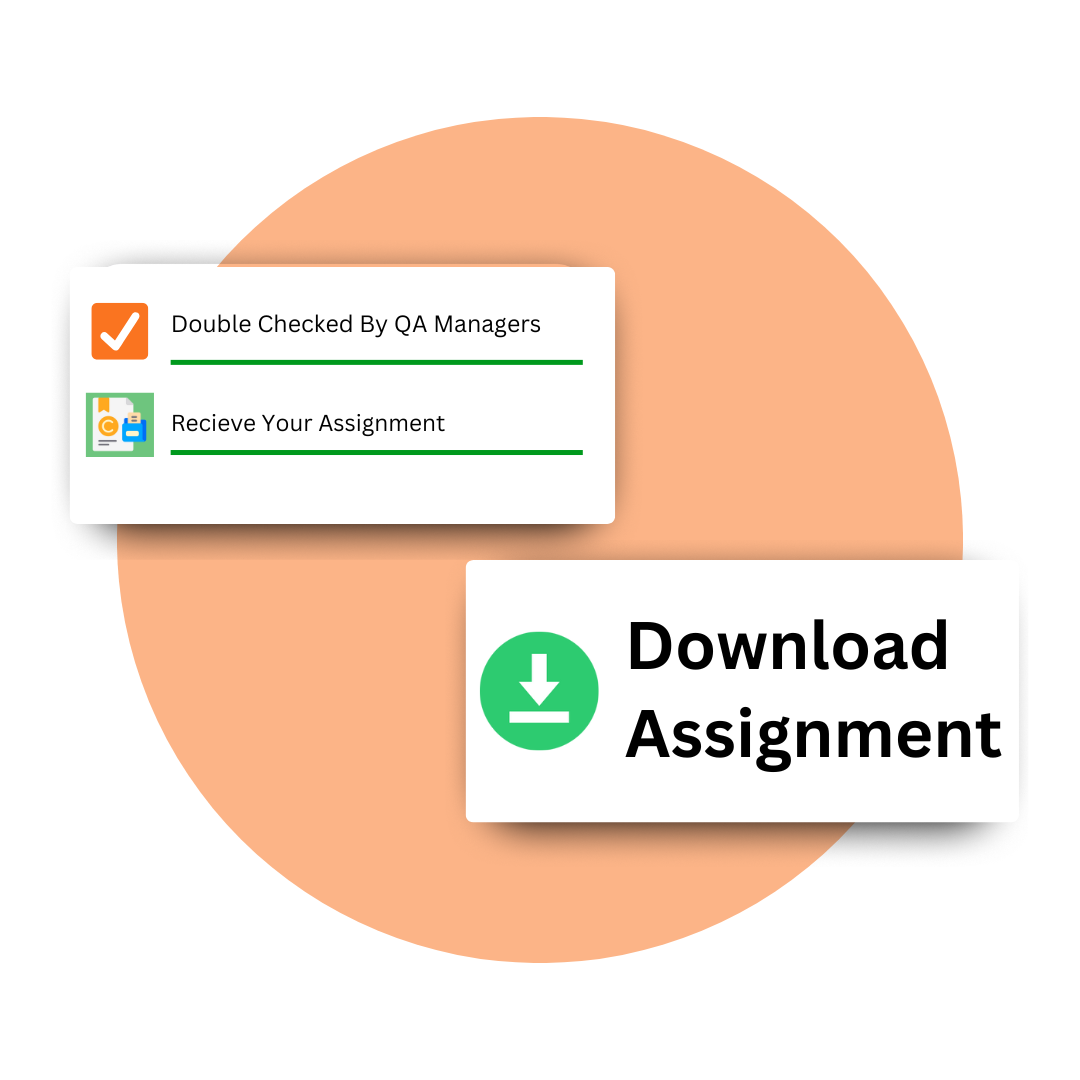We made our process simpler so you can get your 5HRF assignment help with ease

Start your journey by providing details about your assignment. Specify the topic, deadline, and any specific requirements you have.

We’ll review your request and provide a competitive quote. Once you confirm, proceed with the secure payment to kickstart your order.

Sit back and relax! You’ll receive your expertly crafted assignment right on time, ready for submission. Enjoy the peace of mind that comes with academic success!
Our services are transparent with no extra taxes, so you can avail of quality assignment service without breaking the bank.
Your satisfaction is our priority. We offer free unlimited revisions, so you can request modifications until your assignment meets your expectations.
Our dedicated support team is available 24/7 so you can address your queries and concerns. Whenever you need.
Our expert writers will write your assignment from scratch that is uniquely tailored according to your needs. This will ensure that our content is 100% human-written and genuine.
The CIPD Level 5 HRF complexity often makes these assignments seem daunting, but you are under no obligation to undertake this journey alone. Our assignment answers are engineered to equip you with the knowledge and expertise needed to excel in your studies. We strive to create high-quality, bespoke content that suits your specific requirements, and thus each assignment is draughted by professionals who boast real-world experience in HR.
By choosing our assignment services, you will acquire individualised support, prompt feedback, and total resources that help give you an edge in learning. From the very intricate theories concerning HR to employment law and organisational behaviour, our experts are there to guide you and give you just the right push you need towards realising your academic success.
Let no challenges deter you; let’s partner on your way to excellent grades and HR career success in our CIPD Level 5 HRF assignments.
The function of HR is placed at the heart of helping organisations achieve their business objectives by putting the right people in place and processes and maintaining the workforce as motivated and aligned with the company’s goals.
Key Functions of HR Include:
Recruitment and Selection: Ensuring the right talent hires.
Learning and Development: It helps to develop the skill levels of the workforce.
Performance Management: Design of performance work goals and giving of feedback
Employee Relations: Management of Employee Relations to make communication easier
Compliance Management: It ensures that labour laws and internal policies are respected.
These functions have lots of overlap, and if it is implemented correctly, then the pathways leading to a higher level of performance, better employee satisfaction, and being ahead in the competitive environment are smoothed.
HR, in today’s business environment, supports the strategy by collaborating with the leadership to help shape business outcomes. It influences workplace planning decisions, organisational design, and employee engagement strategies.
Strategic Role of HR: Examples:
Strategic involvement means relating the organisation’s human capital to its business, which will help build an organisational ladder that leads to a sustainable path to success.
Human resource policies are guidelines that provide direction in instances of making decisions. Human resource policies give employees and management a set of rules that they need to adhere to. It contains issues such as recruitment, discipline, and grievance procedures. Proper policies, therefore, ensure consistency, fairness, and transparency.
Some examples of policies include:
Equal Employment Opportunity Policies: These policies ensure that there is no workplace discrimination.
Health and Safety Policies: These policies ensure the well-being of employees at work.
Leave Policies: Outline guidelines for vacation, sick, and parental leave.
Operationalised appropriately, these policies foster an atmosphere of trust within the organisation, minimise exposure to legal liabilities, and provide a more considerate work environment.
Non-compliance with any employment legislation may bring legal sanctions, financial loss, and negative results for the reputation of the company. Thus, HR professionals should guarantee compliance with local and national laws, like those governing working hours, employees’ rights, and health and safety standards.
Examples of Key Legislation:
Failure to comply may result in adverse effects on the morale of the employees, grievances, and even penalties the organisation has to face. Hence, HR needs to be updated about legislation and its implementation in best practices to avoid such risks.
Effective human resource management requires integration and coordination from departments to facilitate smooth policy and procedure implementation.
Examples of Cross-Department Coordination
Finance: Coordinates with the HR on payroll, budgeting, and other benefits-related activities
IT: Helps implement HR systems and secure data
Operations: Coordinates workforce planning in line with operational needs.
Coordination in an integrative manner affords uniformity in all processes, as well as fosters the development of employees’ experiences and helps maintain policies in compliance. It also facilitates the enhancement of communication and the elimination of process inefficiencies.
A significant constituent of modern-day human resource management is technology. HRMS encompasses the recruitment process from all perspectives of payroll management, as well as performance management in its entirety. The LMS for human resources includes training access.
Benefits of Technology in HR:
Efficiency: It automates payroll processing and attendance tracking, which are time-consuming activities.
Analytical Insights: Analysis is summarised for better workforce planning.
Better Communication: Portals enhance transparency and communication.
Accuracy, reduction in manual burdens, and enablement of the HR function with scope towards more strategic tasks that add more value to an organisation by the implementation of HR technology.
HR identifies skill gaps and puts learning programmes in place to improve the capabilities of employees. Structured development programmes will enhance job performance and retention rates.
Examples of Learning Initiatives:
Training Programmes: Normally equip employees with new technical and soft skills.
E-learning Courses: These facilitate flex-learning.
On-the-job training increases practical experience and skills.
Through a continuous learning culture, HR ensures the organisation remains competitive while ensuring that the employees are motivated to develop in their roles.
Training programmes have a critically significant impact on the morale of the employees, their productivity, and retention within the organisations. An employee whom an organisation supports in his or her personal and professional growth is likely to continue to commit themselves to the organisation.
Impact on Engagement and Retention:
Elevated job satisfaction: People tend to feel appreciated when their skills are being developed.
Decreased Turnover Rates: Those development opportunities reduce the chances that the employees may quit.
Improved Productivity: Trained workers perform their duties with greater efficiency
An organisation that is investing in its workers’ education will be able to retain top talent, and those people are likely to have high engagement.
Performance management is about orienting staff activities towards achieving organisational goals. It encompasses the matching of performance expectations, tracking of progress, and also giving feedback on time.
Performance management tools: examples
Key Performance Indicators (KPIs): Tracks the employee’s contribution to achieving the company’s goals.
360-Degree Feedback: Multiple sources of feedback are given to an employee to enhance his performance.
Performance Reviews: Assess the strengths and weaknesses of employees.
Effective performance management builds a performance work culture in which individuals know what they do and deliver accordingly for positive business outcomes.
HR plays a significant role in identifying the performance problem and solving it in the early stages before the minor issues turn into big issues that are harmful to the output of the organisation.
Examples of HR’s role in managing performance issues:
Coaching and counselling: Bring them back on track.
Performance Improvement Plan (PIP): Give some structured support to employees who have some performance issues.
Mediation and Conflict Resolution: Resolve the workplace conflicts that go against the performance
Proactive management of performance issues creates a healthy work environment while making sure productivity and engagement in the workplace stay intact.
High grades achieved in Managing and Coordinating the Human Resources Function unit 5HRF Assignment help
A
Aisha Rahman

I was struggling with my CIPD Level 5 case study, but the team at cipdassignmenthelper.ae provided invaluable assistance. Their expert insights and structured approach helped me achieve a high grade. I couldn’t have done it without their support!
M
Mohammed Zayed

The support I received for my CIPD Level 5 assignments was exceptional! The writers understood the requirements perfectly and delivered work that exceeded my expectations. I felt confident submitting my essays, knowing they were top-notch.
M
Mansoor Ali

I was struggling with some CIPD Level 5 concepts at London American City College, but the CIPD Assignment Helper clarified everything. Their assignments are detailed and thorough, and my confidence has skyrocketed!
A
Asma

The experts at CIPD Assignment Helper were friendly and knowledgeable. Studying CIPD Level 5 at the University of Wollongong in Dubai is tough, but their support helped me stay on track and succeed in my assignments.
H
Hassan Raheem

Studying CIPD at Blue Ocean Academy in Dubai is demanding, but CIPD Assignment Helpers made it so much easier. They handled my CIPD Level 5 assignments professionally and provided the best assignments that made me stress-free of assignments.
Z
Zayed Hussain

CIPD Assignment Helper is a budget-friendly option for my CIPD Level 5 assignments. The quality they give for the price is unbeatable. I got excellent grades and I’ll use them again.
Order now and experience what our professional written, non-AI help can make.
